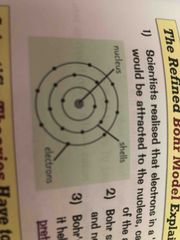![]()
![]()
![]()
Use LEFT and RIGHT arrow keys to navigate between flashcards;
Use UP and DOWN arrow keys to flip the card;
H to show hint;
A reads text to speech;
13 Cards in this Set
- Front
- Back
|
Solids |
Strong forces of attraction. Particles don’t move and stay in a regular pattern. The particles vibrate about fixed positions. If you heat a solid it will give the particles more energy and the split will melt to form a liquid. |
|
|
Liquids |
There is some force of attraction. They are free to move past each other and will fill the shape of a container. |
|
|
Gas |
No force of attraction. They travel in straight lines and only interact when they collide. They don’t keep a definite shape and will exert pressure and fill a container. They move constantly with random motion. |
|
|
What happens to atoms in a helical reaction? |
Atoms are rearranged and the bonds between them are broken so that they can change places. |
|
|
Plum pudding model |
JJ Thompson created the plum pudding model which suggested that an atom was a round ball with electrons embedded throughout. |
|
|
Rutherford. Geiger. Marsden |
They conducted the gold foil test where they shot alpha particles at a sheet of gold foil they expected the atoms to pass straight through but instead most of the atoms were deflected and some were deflected straight back the way they came. |
|
|
Bohr model |

Back (Definition) |
|
|
Mass number? |
Total number of protons and neutrons (bigger one). |
|
|
The atomic number? |
Number of protons. |
|
|
Protons |
Heavy and positively charged. Found in the nucleus. |
|
|
Electrons |
Have hardly any mass and are negatively charged. Downs orbiting the nucleus in shells. |
|
|
Neutrons |
Heavy and neutral found in the nucleus. |
|
|
Isotopes |
Different forms of the same element which have the same number of protons but a different number of neutrons. |

